6 Using AI to Enhance Student Learning
This chapter explores how AI tools can be used:
- to tutor students;
- to simulate real-world tasks, from a salary negotiation to an engine overhaul;
- to generate practice questions based on a topic or text;
- to teach a concept using analogies or examples;
- to help language learners build their vocabulary;
- to support reading, research, and writing skills development.
AI as a Personal Tutor
AI-based learning allows students to actively engage by interacting with AI tools to learn the skills required for a particular task. AI-based individual tutoring can adapt to each student’s learning style, pace, and preferences, offering a personalized educational experience. Since AI tools can produce errors, AI-based tutoring is best used as a supplement to readings or lectures, which will supply students with a base of knowledge on which to fact-check AI output. Multipurpose AI tools can act as a personal tutor, as can specialized tools like AI Tutor Pro.
AI as a Simulation Tool
AI tools are well-suited to function as a simulator, allowing students a low-stakes, low-pressure opportunity to apply knowledge before engaging in a real-world task.[1] The following table illustrates some sample applications for AI as an in- or out-of-class simulation partner.
| Area |
Task for Simulation | Sample Interaction with AI Tool |
| Business, legal | Negotiation | ChatGPT can be prompted to act as business or legal negotiating counterpart. |
| Hospitality management | Event planning | AI chatbots can be prompted to simulate the planning and execution of an event, incorporating common issues that arise. |
| Healthcare | Patient interaction | PCS allows students to practice opposite an avatar of a patient, and view themselves from a patient’s perspective. |
| ESL | Conversation practice | Quizlet’s Q-chat can act as a conversation partner or quizmaster. |
| Trades | HVAC installation, repair, and maintenance | Among others, SkillCat has AI simulations on dozens of tasks from changing an air filter to wiring a compressor. |
| Indigenous language learning | Pronunciation and conversation practice | Rongo evaluates and corrects pronunciation of Maori learners, and several other apps are in development for Indigenous languages in Canada. |
| Technology | Cyberattack response | AI chatbots can produce detailed and iterative simulations of cyberattacks. |
| Business | Pitching a business plan | Shark Tank AI offers a fun and engaging way of getting detailed feedback on a business plan. |
In many of the above examples where a specific AI tool is mentioned, multi-purpose AI tools like Copilot, Gemini, and ChatGPT can often complete the same tasks, but potentially with a less immersive visual environment.
Here is one example of prompting an AI tool for an iterative simulation—click the image for the full interaction (ChatGPT login required). Note how ChatGPT handles a poor answer from the student (about the Breakout Sessions issue).
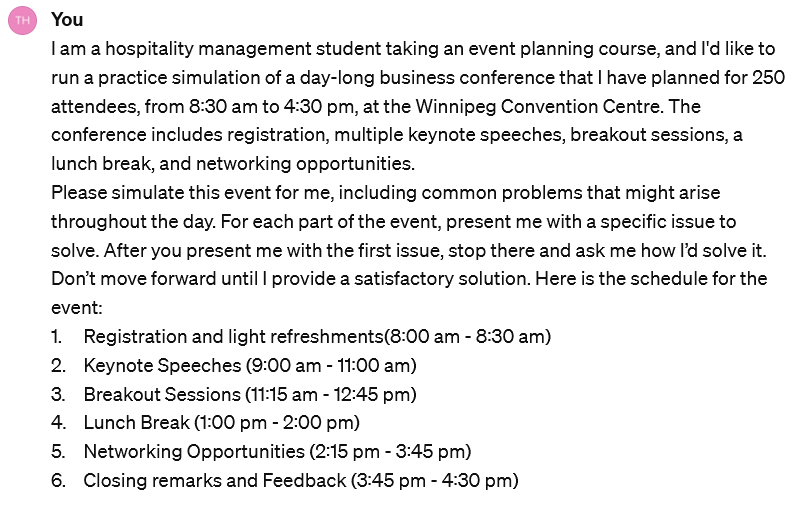
AI as Practice Question Generator
RRC Polytech reference technician Rosemary Woodby encourages students to use AI tools as a “study buddy” to generate practice questions.[2] In this way, students have an extensive supply of example questions or problems, and can also generate questions that are adapted to their learning style, appropriate for their language level, or connected to an area of interest. AI tools can generate matching activities,[3] multiple-choice questions, cloze passages,[4] word problems, crossword puzzles, and short- or long-answer questions. AI tools can even be prompted to present a series of practice questions in a fun and familiar format, like Who Wants to Be a Millionaire? or Family Feud.[5] Here is an example of using ChatGPT to run a Jeopardy!-style practice quiz on the Manitoba Electrical Code. Click the image to see the full interaction, including the original prompt, and the reprompting needed to have a table displayed (login required).
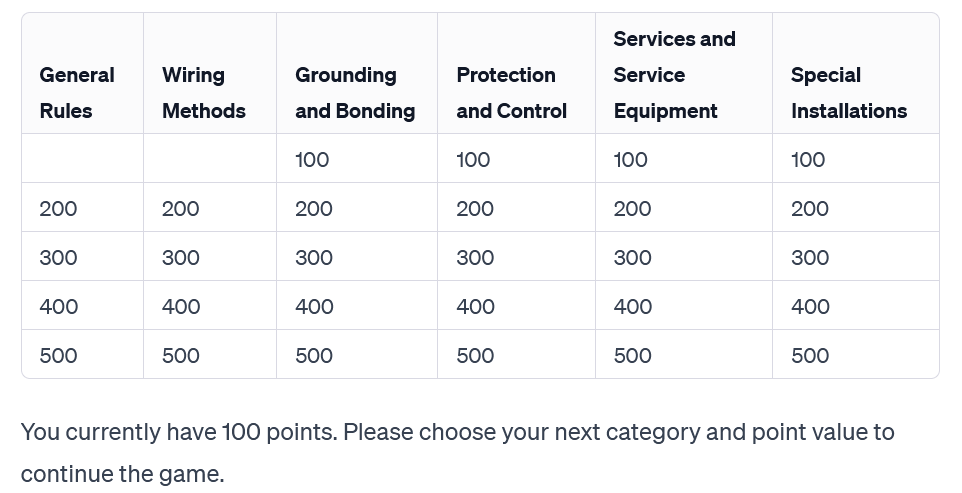
In addition to the large language models listed above, a number of specialized AI tools exist solely to produce sample questions, with or without supplied materials—Quizgecko and Testportal are two examples. Of course, students need the subject matter knowledge and critical thinking skills to understand when an AI tool has provided an incorrect answer, or when it has misevaluated a response. Woodby encourages students to think of AI as “your less-than-reliable friend” who knows about a lot of things, but can’t be trusted to always provide accurate information.[6]
It’s important for students to be aware of copyright and academic integrity concerns that may arise when uploading protected course materials to an AI tool. When recommending AI-based practice questions to students, instructional staff should include information about which course content is protected and cannot be shared with an AI tool, or can only be shared with the data collection feature disabled.
Analogies and Examples
For students who are having difficulty understanding a concept, AI tools can provide analogies to connect the topic to an area of prior understanding.[7] Students can benefit from having an AI tool produce a metaphor comparing a challenging concept to a familiar concept from their area of study, or to a sport, movie franchise, or everyday process. These tailored explanations provide new pathways to understanding a concept. They add an element of novelty that can boost enjoyment of learning and lengthen attention spans, and serve as a mnemonic aid. Here’s an example of ChatGPT explaining a marketing concept in hockey analogies. Click the image to see the full interaction (login required).
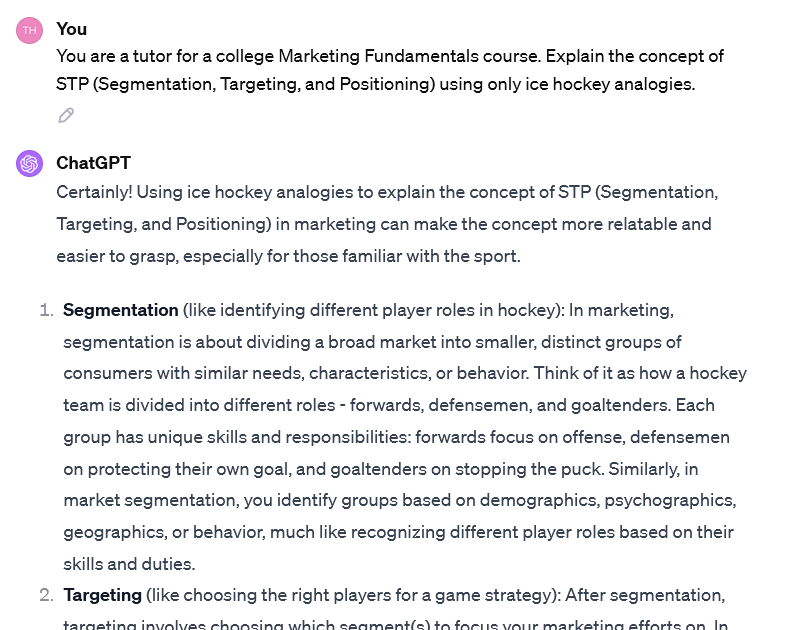
AI tools can also provide volumes of examples to connect new concepts to real-world tasks or to prior knowledge.[8] AI tools can be prompted to produce examples that are tailored to a specific industry or position, geographical location, cultural context, project, or task. Here’s how ChatGPT provides examples connecting an aircraft maintenance engineer course concept to a real-world workplace. Click the image to see the full interaction (login required).
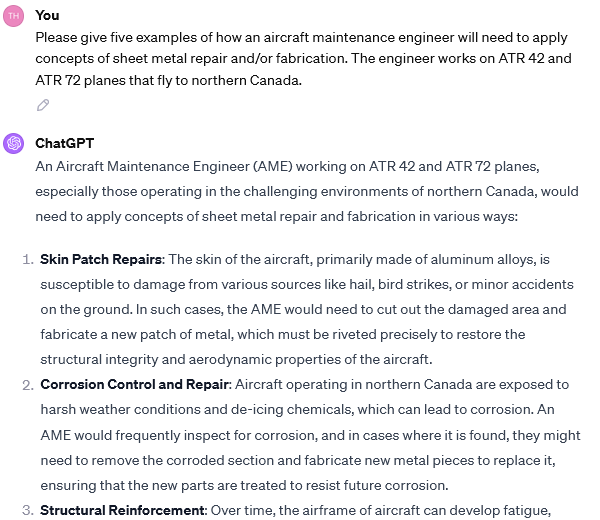
AI for Language Learning
AI tools have numerous applications for language learning. RRC Polytech ESL instructor L. Brunette uses Quizlet’s Q-Chat for vocabulary building and sentence structure development. After customizing a vocabulary set for the week, Brunette sets students up to have Q-chat quiz them on the words. The app can ask students to define a word or use it in a sentence, and will give detailed feedback on their answers. This gives students a 24/7 source of formative feedback and reduces instructor marking load. Brunette reports that students find the app especially useful since they can complete their vocabulary practice anywhere, like while riding the bus to class.[9] Another useful feature of Q-Chat is Story Mode, which can generate a story that incorporates vocabulary from the set, and a corresponding set of comprehension questions.[10]
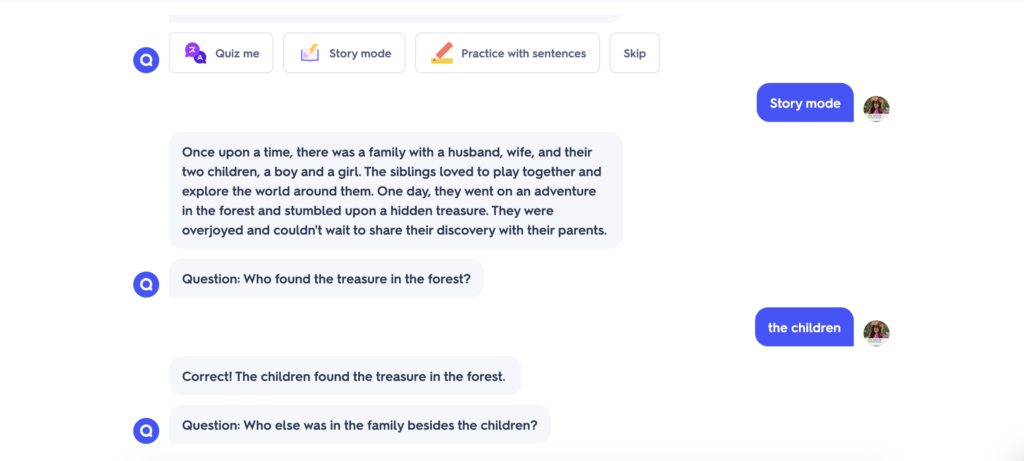
Reading and Research Skills Development
AI tools can be used to assist with reading and research by summarizing a text or passage, scanning for content on a theme, adapting a text to a student’s reading level, or translating it into another language. More advanced research uses for AI tools include uploading multiple articles and asking an AI tool for comparisons, takeaways, and strengths and weaknesses. Consensus and Elicit are two tools equipped to handle this kind of processing.[11] The reading capabilities of AI tools are a time-saver for students, allowing them to quickly focus their research, cast a wider net, and allocate significant time to analysis and writing.
The following example shows how an AI tool can be prompted to review resources for content on a particular topic. Click the image to review the full conversation (ChatGPT login required). Note the initial prompts in which the user has the AI tool define the concept of reciprocity and list some related terms. Without these initial prompts, ChatGPT did not perform nearly as well on this task.
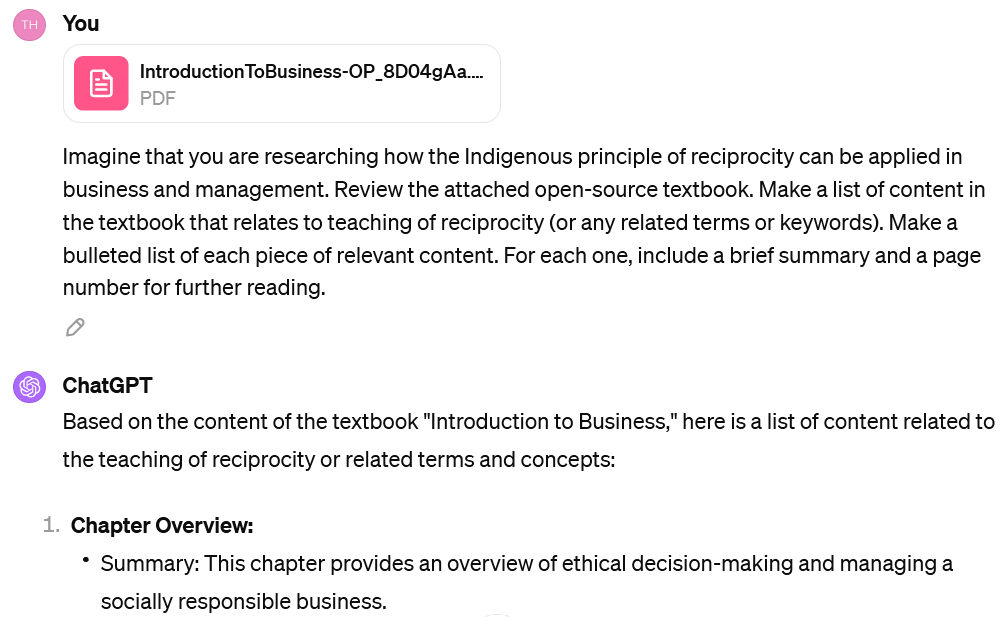
Since gathering information from documents is likely to be an important skill into the future, AI tools should be used as an enhancement to a traditional research process rather than a replacement. Marc Watkins of the University of Mississippi notes that AI tools like ExplainPaper and SciSpace are useful for students with disabilities and low language levels, but could hinder their ability to develop close reading skills. Watkins recommends that students reserve the use of AI tools until they hit a “pain point” in a text, one that would normally cause a barrier to comprehension.[12]
Writing Skills Development
In the same way that Watkins worries about AI’s effects on close reading skills, many instructors worry about its effects on student writing development. There are a number of ways students can use AI tools to write more effectively while also developing their writing skills. One idea is to use a multipurpose AI tool like Gemini or specialized tool like MyEssayFeedback to give formative feedback on an early draft. Prompts can include specifics about what the student would like the AI tool to look for, like tone, organization, coherence, or conciseness. When suggesting that students submit written work for AI-based formative feedback, instructional staff should include information about how AI tools may incorporate submissions into their training data unless the data collection setting is turned off.
Some AI tools may attempt to revise a student’s work unless specifically instructed not to. One way to avoid this is explicitly prompting the tool to provide a bulleted list of suggestions for improvement (this can even be added as a universal custom instruction). Evaluating an AI tool’s list of suggestions for improvement and deciding which ones to incorporate involves reflecting and thinking critically about our writing as well as the abilities of the AI tool. Students who have language or writing difficulties can ask AI to explain each suggestion for improvement, such as why a grammatical error is an error.[13] Here is an example of a prompt asking for feedback on a piece of writing.
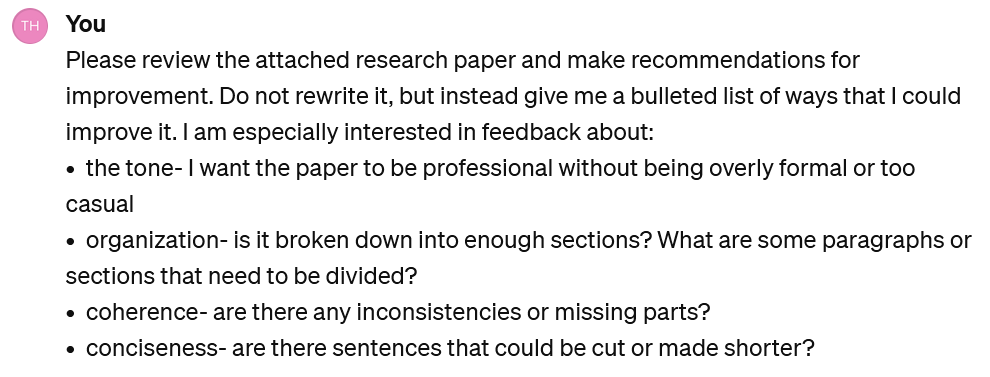
Key Takeaways
AI tools can enhance student learning by:
- acting as a personal tutor;
- carrying out detailed simulations of future workplace tasks;
- producing volumes of sample questions based on a theme or supplied resource, and responding with feedback to answers;
- explaining a topic using analogies or examples tailored to a student’s areas of knowledge or interest;
- quizzing language learners on a set of vocabulary words;
- providing assistance with reading and research tasks;
- reviewing a piece of writing and making suggestions for improvement.
In all cases, AI tools can make errors. Students engaging with AI tools need enough subject-matter knowledge to recognize AI hallucinations, and need to know how to fact-check AI output.
Exercises
- Reflect on ways that students in your courses could use AI to enhance their studying and learning. Which methods would you be most likely to recommend? What would you want students to know about AI tools before they dive in?
- Consider ways that AI tools can assist with reading, research, and writing. How can students use AI tools in ways that help to develop their reading and writing abilities? What is the role of educators in ensuring that students use AI tools responsibly in the reading and writing process?
- Danny Liu, "Prompt Engineering for Educators—Making Generative AI Work for You," University of Sydney, last modified April 27, 2023, https://educational-innovation.sydney.edu.au/teaching@sydney/prompt-engineering-for-educators-making-generative-ai-work-for-you/. ↵
- Rosemary Woodby, focus group, November 6, 2023. ↵
- CampGPT, "Open Prompt Book," Crowded Learning, last modified November 1, 2023, https://edtech.worlded.org/wp-content/uploads/2023/07/campgpt-prompt-book-2-compressed.pdf ↵
- "Prompts to help you learn," University of Sydney, accessed January 17, 2024, https://canvas.sydney.edu.au/courses/51655/pages/prompts-to-help-you-learn-2?module_item_id=2035977 ↵
- Chrissi Nerantzi, Sandra Abegglen, Marianna Karatsiori, and Antonio Martínez-Arboleda (Eds.), "101 Creative Ideas to Use AI in Education, A Crowdsourced Collection," Zenodo, last modified 2023, https://doi.org/10.5281/zenodo.8072950. ↵
- Woodby, 2023. ↵
- Danny Liu, "Prompt Engineering for Educators–Making Generative AI Work for You," University of Syndey, last modified April 27, 2023, https://educational-innovation.sydney.edu.au/teaching@sydney/prompt-engineering-for-educators-making-generative-ai-work-for-you/. ↵
- Danny Liu, "Prompt Engineering for Educators–Making Generative AI Work for You." ↵
- L. Brunette, focus group, November 25, 2023. ↵
- Rachel Hernandez, "Quick and Quirky Stories for the Language Classroom: Exploring Quizlet's AI-Powered Q-Chat," FLTMAG, last modified May 15, 2023, https://fltmag.com/quizlet-q-chat/. ↵
- Marc Marino, "Reading and Researching with LLMs," Exploring AI Pedagogy: A Community Collection of Teaching Reflections," last modified November 27, 2023, https://exploringaipedagogy.hcommons.org/2023/11/27/reading-and-researching-with-llms/ ↵
- Marc Watkins, "Reading Assistants: ExplainPaper and SciSpace," Exploring AI Pedagogy: A Community Collection of Teaching Reflections, last modified November 27, 2023, https://exploringaipedagogy.hcommons.org/2023/11/27/reading-assistants-explainpaper-and-scispace/ ↵
- Ethan Mollick, "The Practical Guide to Using AI to Do Stuff," One Useful Thing, last modified January 24, 2023, https://www.oneusefulthing.org/p/the-practical-guide-to-using-ai-to?r=i5f7&utm_campaign=post&utm_medium=web ↵
A feature that users can toggle on some AI tools. When data collection is turned off, the tool will not use inputs to improve its models. To toggle this setting in ChatGPT, click on the user name in the bottom right corner, then Settings, Data Controls, Chat History & Training.
A set of instructions that a user establishes with an AI tool, which apply to all of their interactions. Custom instructions can be set in ChatGPT by clicking on the user's name near the bottom left corner, then on Custom Instructions.
Incorrect information supplied by an AI tool as if it were factual.

